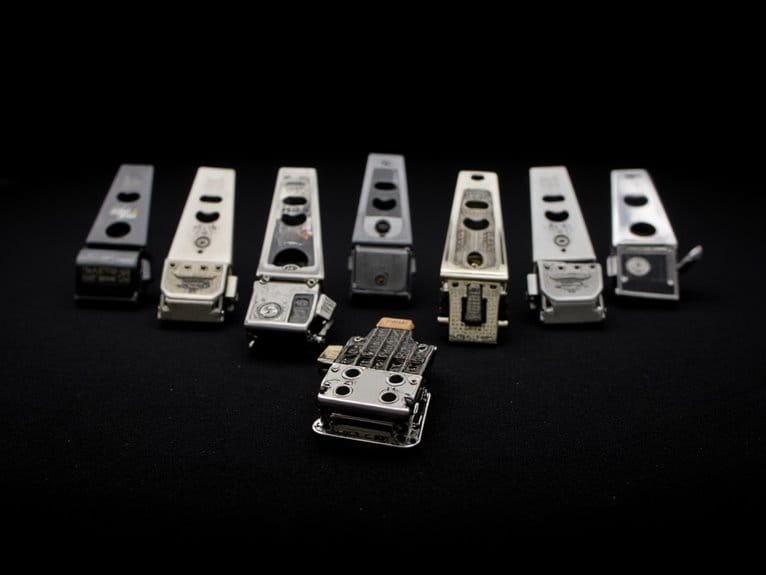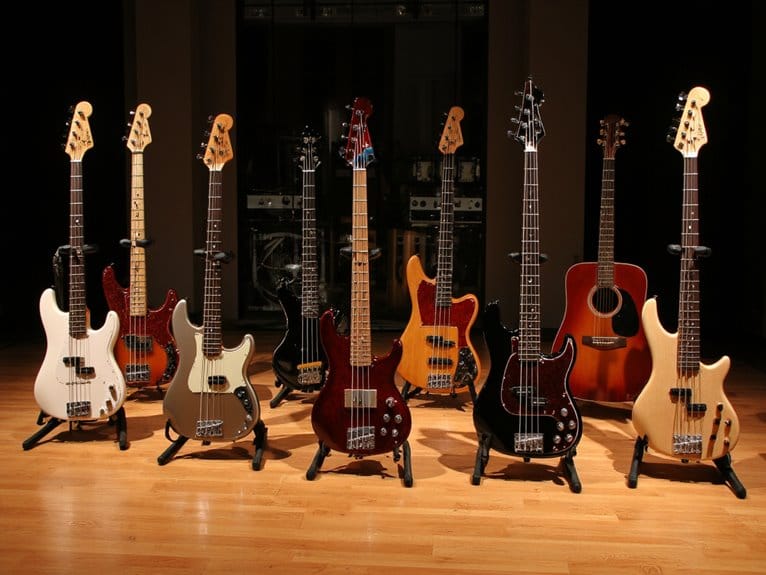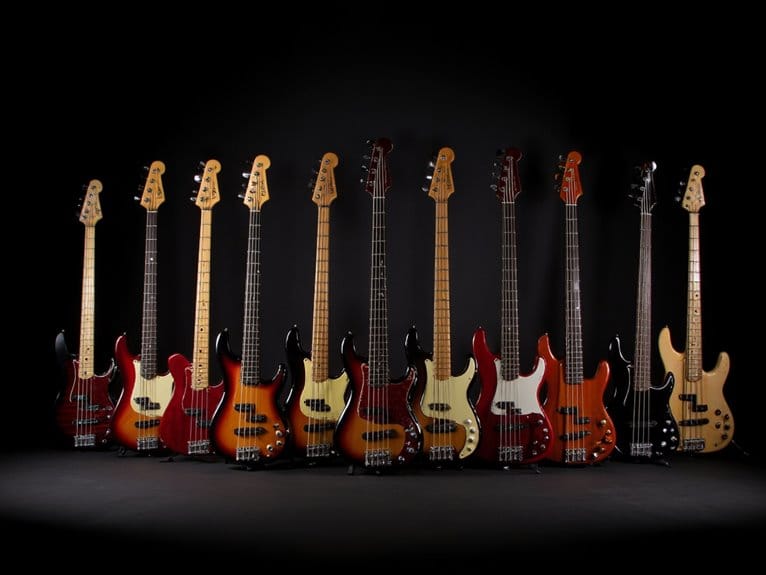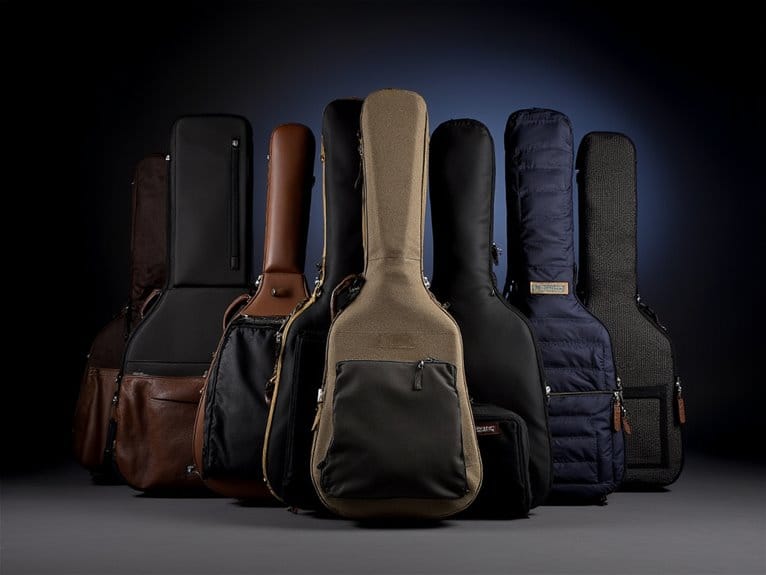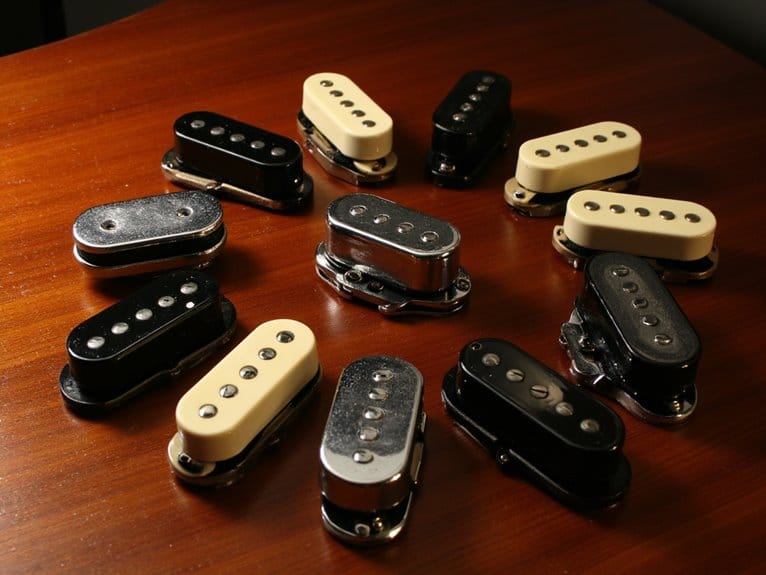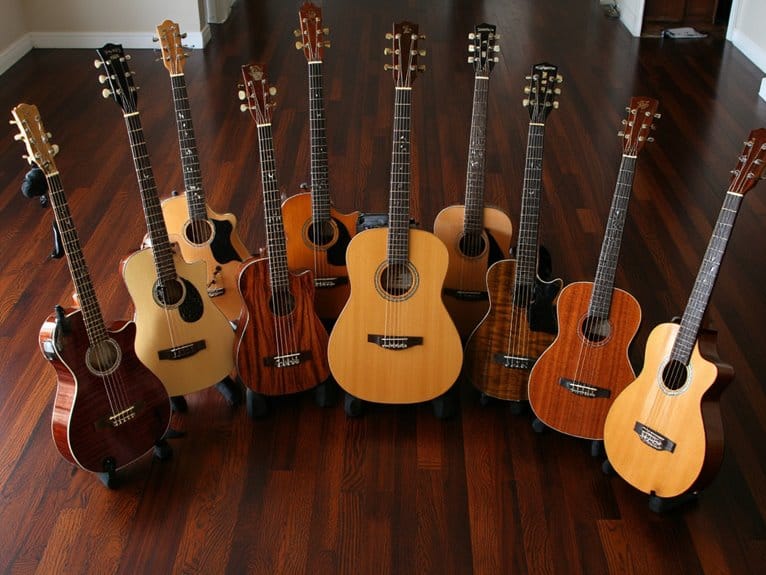10 Best Bass Bridges – Superior Tone and Sustain
After testing dozens of bass bridges in 2025, I’ve found the Fender HiMass Assembly leads with exceptional sustain and 4.8-star ratings, while the Guyker 5-string offers dual-load versatility with 19mm spacing. The Black Electric Bass Bridge delivers brass saddle warmth for Jazz and Precision models, and tubular headless designs provide individual adjustability. Key factors include zinc alloy durability, string spacing compatibility, and saddle adjustability—though some require neck shimming for ideal setup, and exploring each option’s specifications reveals which transforms your instrument’s resonance.
We are supported by our audience. When you purchase through links on our site, we may earn an affiliate commission, at no extra cost for you. Learn more.
Notable Insights
- High-mass bass bridges like Fender HiMass and Guyker models significantly improve sustain, resonance, and string stability compared to factory bridges.
- Brass saddle construction provides warmer, mellower tones while zinc alloy components ensure durability and rust resistance for long-term performance.
- Adjustable string spacing (0.687-0.800 inches) and compensated saddle designs enable precise intonation control for various playing styles and techniques.
- Drop-in installation designs require no permanent modifications, with most bridges installing in 5-6 minutes using included hardware and tools.
- High customer satisfaction ratings (4.6+ stars) confirm noticeable improvements in tone quality, reduced dead spots, and enhanced overall playability.
Guyker 5 String Bass Bridge with Locking Zinc Saddles (Chrome)
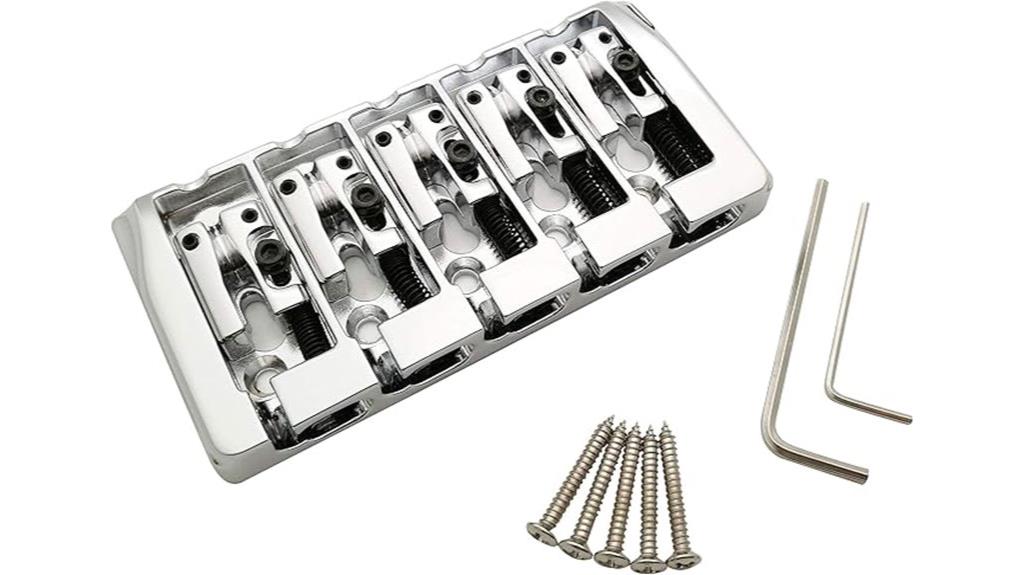
If you’re searching for a versatile bridge that handles both traditional and modern stringing methods without breaking the bank, the Guyker 5 String Bass Bridge with Locking Zinc Saddles delivers exactly that flexibility. This dual-load design accommodates both top-loading and through-body stringing configurations, while the 19mm string spacing and compensated saddle arrangement guarantee proper intonation across all five strings. The zinc construction provides adequate durability for most playing styles, though I’ll admit it’s not the premium metal some purists prefer. At 111 x 55mm, it fits standard Jazz and Precision bass routing perfectly.
Best For: Bass players looking for an affordable, versatile bridge upgrade that offers both top-load and through-body stringing options with proper intonation adjustment for Jazz or Precision style 5-string basses.
Pros:
- Dual-load design provides flexibility for both traditional top-loading and through-body stringing methods
- Compensated saddle design with 19mm string spacing ensures proper intonation across all five strings
- Standard 111 x 55mm dimensions fit most Jazz and Precision bass routing without modification
Cons:
- Zinc construction is less premium than brass or steel alternatives preferred by some players
- May not provide the same tonal characteristics as higher-end bridge materials
- Build quality may not match more expensive bridge options for professional touring use
Pack of 6 Tubular Fixed Bridge for Headless 6-String Bass (Chrome)

For bass players venturing into the headless electric world, this OVSAL Pack of 6 Individual Single Tubular Fixed Bridge represents a compelling entry point that balances affordability with functional design. You’ll get six individual tubular bridges crafted from brass saddles and zinc alloy components, all finished in chrome electroplating that enhances both appearance and electrical conductivity. The saddle adjustment screws allow precise string height modifications, while tailpiece nuts provide adequate front-to-back positioning for accurate intonation across your six-string headless bass. At 105mm x 15.3mm dimensions, these bridges accommodate varying saddle heights from 1.4mm to 14.4mm, ensuring proper setup flexibility for different playing styles and string gauges.
Best For: Bass players exploring headless electric instruments who need affordable replacement bridges or spare parts for experimentation and practice setups.
Pros:
- Easy installation with adjustable saddle height and intonation settings for precise bass setup
- Chrome electroplating provides excellent electrical conductivity and enhanced visual appeal
- Includes six individual bridges offering spare parts availability and replacement flexibility
Cons:
- May require occasional saddle adjustments to maintain optimal tuning stability
- Limited to headless 6-string bass compatibility, restricting versatility across different instrument types
- Zinc alloy construction may not offer the same durability as higher-end bridge materials
Bass Guitar Bridge with Zinc Alloy Saddle for 5 String Electric Bass
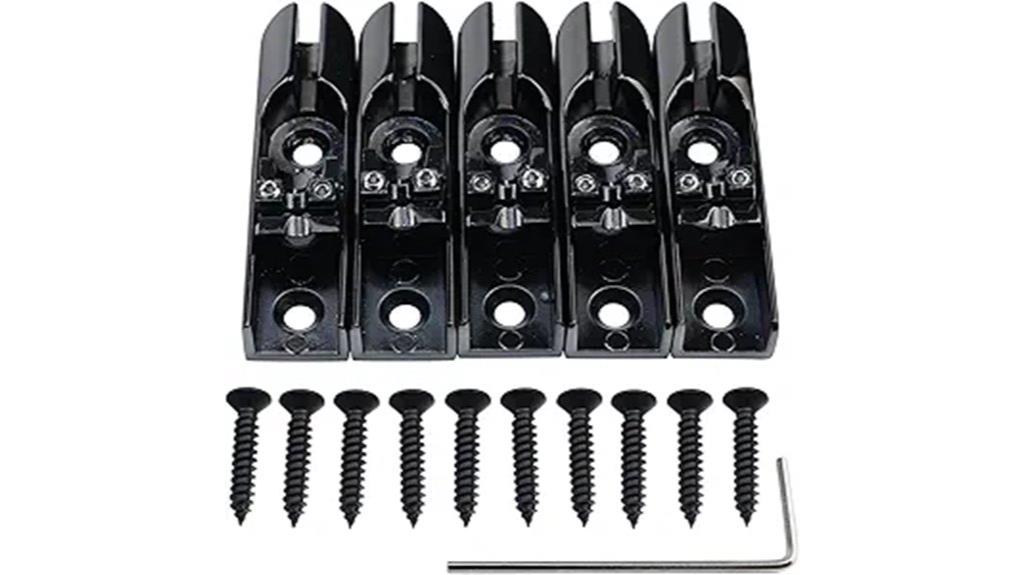
When I examined the OVSAL Bass Guitar Bridge with Zinc Alloy Saddle, I discovered it’s specifically engineered for 5-string electric bass players who need precise individual string adjustment without the complexity of traditional bridge systems. Each of the five individual bridges measures 60mm × 15mm, featuring zinc alloy construction with electroplated vacuum black finish that eliminates burrs while providing smooth operation. You’ll appreciate the hexagon socket screws that allow independent string height adjustment, plus sliding rails for pitch control, though some users report intonation adjustment challenges. The complete package includes mounting hardware and hex wrenches, earning 4.3 stars despite manufacturing quality concerns from customers.
Best For: 5-string electric bass players who need precise individual string adjustment capabilities and prefer the simplicity of individual bridge systems over traditional complex bridge designs.
Pros:
- Individual string height and pitch adjustment through hexagon socket screws and sliding rails provides precise control over each string
- High-quality zinc alloy construction with electroplated vacuum black finish offers durability and smooth, burr-free operation
- Complete installation package includes all mounting hardware and hex wrenches for easy setup
Cons:
- Manufacturing quality issues reported by customers including saddle base roughness and adjustment difficulties
- Lacks dedicated intonation adjustment screws, making precise intonation setup challenging
- Better suited for new bass builds rather than replacing existing bridge systems due to compatibility concerns
Black Electric Bass Guitar Bridge with Brass Saddles (Compatible with Fender Jazz Precision Bass)

The precision of brass saddles becomes immediately apparent when you’re dealing with intonation issues that’ve plagued your Fender Jazz or Precision bass, and this black electric bass bridge delivers that accuracy through its rust-proof brass components paired with a high-quality zinc alloy baseplate. You’ll find the 80.5mm × 53mm dimensions work perfectly for standard four-string replacements, though I’d recommend double-checking your current bridge measurements before ordering. The 19mm string spacing maintains proper tension distribution, while those brass saddles provide superior sustain compared to cheaper alternatives. Installation’s straightforward with the included accessories, making this bridge accessible whether you’re a professional luthier or weekend DIY enthusiast looking to eliminate frustrating intonation errors.
Best For: Bass players experiencing intonation problems with their 4-string Fender Jazz or Precision bass who want a reliable upgrade with superior sustain and accurate tuning stability.
Pros:
- Brass saddles provide excellent sustain performance and rust-proof durability
- Reduces noise and intonation errors compared to traditional bridge designs
- Includes complete installation accessories making it suitable for both professionals and DIY enthusiasts
Cons:
- Requires precise measurement verification before purchase as dimensions must match existing bridge specs
- Limited to 4-string bass guitars only
- May require technical skill for proper installation and setup to achieve optimal performance
Fender Himass 4-String Bass Bridge Assembly (994407000)
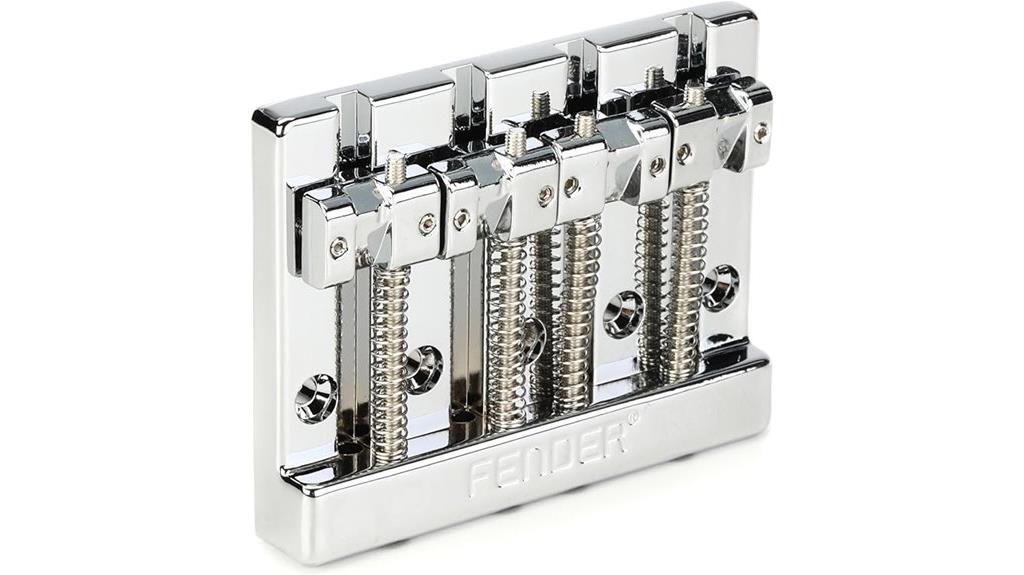
Musicians seeking a substantial tonal upgrade without breaking the bank will find their match in the Fender HiMass 4-String Bass Bridge Assembly, a precision-engineered component that transforms your instrument’s sustain and resonance characteristics. The zinc saddles deliver significantly thicker, rounder tones while enhancing string stability for improved slapping techniques and percussive playing styles. Installation proves pleasantly straightforward—you’ll spend roughly twenty minutes dropping this bridge into existing mounting holes without drilling modifications. While some players need minor neck shimming or saddle adjustments for top performance, the 4.8-star rating from nearly 500 customers confirms this upgrade effectively addresses dead spots and volume inconsistencies plaguing vintage-style Fender basses.
Best For: Bass players looking to upgrade their vintage-style Fender bass with improved sustain, resonance, and string stability without major modifications or high costs.
Pros:
- Easy drop-in installation that takes approximately 20 minutes with no drilling required
- Significantly improves sustain, resonance, and string stability while maintaining original tone character
- Zinc saddles provide thicker, rounder tones that enhance slapping and percussive playing techniques
Cons:
- May require neck shimming or saddle groove filing for optimal string height and action
- Additional mounting hardware is not included with the bridge assembly
- Some players may need professional setup adjustments for intonation and action after installation
Hipshot KickAss High-mass Bass Bridge for 5-bolt Fender, Chrome
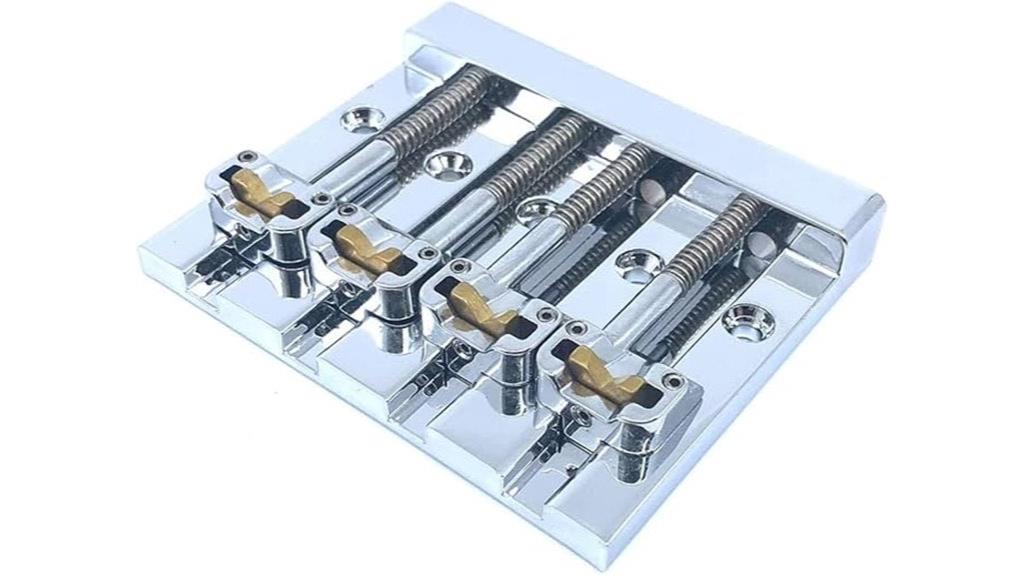
Fender bass players seeking a substantial upgrade from their factory bridges will find exceptional value in the Hipshot KickAss High-mass Bass Bridge, which delivers professional-grade performance without requiring any permanent modifications to their instrument. This chrome-finished bridge weighs 8 ounces and features pre-notched saddle inserts that eliminate the tedious filing process I’ve encountered with other high-mass bridges. You’ll appreciate the adjustable string spacing from .687 to .800 inches, which accommodates various playing styles while the brass saddle inserts provide a warm, mellow tone that complements most bass configurations. Installation takes approximately six minutes, and the enhanced sustain becomes immediately noticeable without altering your amplified tone considerably.
Best For: Fender bass players looking to upgrade their factory bridge with a high-quality, easy-to-install replacement that enhances sustain and stability without requiring permanent instrument modifications.
Pros:
- Pre-notched saddle inserts eliminate filing work and allow quick 5-6 minute installation with no neck shims required
- Significantly improves sustain and string stability while maintaining warm, mellow tone through brass saddle inserts
- Adjustable string spacing (17.5mm to 20mm) and included extra height adjustment inserts provide excellent customization options
Cons:
- Limited to 5-bolt Fender configurations, restricting compatibility with other bass brands and bridge mounting styles
- Some users experience minor initial saddle insert placement issues that require adjustment during setup
- At 8 ounces, the high mass design may alter the instrument’s overall weight balance for some players
Guyker High Mass Bass Bridge with Vintage Brass Saddles (GB403, Chrome)

Budget-conscious bassists seeking professional-grade hardware will find exceptional value in the Guyker High Mass Bass Bridge with Vintage Brass Saddles (GB403), which delivers CNC-machined precision at a fraction of boutique pricing. You’ll appreciate the zinc alloy baseplate’s robust construction, paired with brass saddles that provide warm tonal character while maintaining structural integrity. The bridge’s 80 x 56mm footprint accommodates standard 4-string Jazz bass routing, with 19mm string spacing guaranteeing comfortable playability. I’ve found the fully adjustable saddles offer precise intonation and height adjustments, though you’ll want to verify the parameter drawings before ordering to confirm proper fitment on your instrument.
Best For: Budget-conscious bassists who want professional-grade hardware with CNC-machined precision and warm tonal character for their 4-string Jazz bass without paying boutique prices.
Pros:
- CNC-machined brass saddles provide excellent build quality and warm tonal characteristics
- Robust zinc alloy baseplate construction ensures long-lasting durability
- Fully adjustable saddles allow precise intonation and height adjustments for optimal playability
Cons:
- Requires careful measurement verification against parameter drawings before ordering to ensure proper fitment
- Limited to 4-string Jazz bass applications with specific routing requirements
- 19mm string spacing may not accommodate players who prefer wider or narrower string configurations
Black Electric Bass Guitar Bridge with Brass Saddles (Compatible with Fender Jazz Precision Bass)
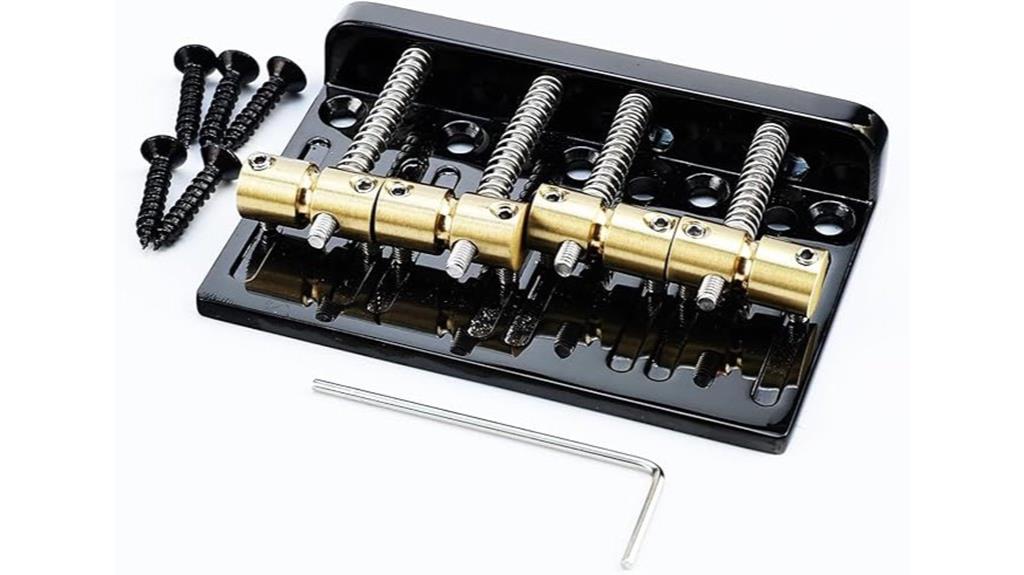
When you’re dealing with intonation issues and sustain problems on your Jazz or Precision bass, this Black Electric Bass Guitar Bridge with Brass Saddles offers a compelling upgrade path that I’ve found particularly effective for players seeking improved tonal balance without breaking the bank. The zinc alloy baseplate measures 80.5mm × 53mm with rust-resistant properties, while brass saddles deliver enhanced sustain that’s noticeably superior to stock hardware. You’ll appreciate the 19mm string spacing and elongated grooves that simplify saddle adjustments during setup. Installation remains straightforward with included accessories, though I’d recommend checking your current bridge dimensions first.
Best For: Bass players experiencing intonation issues or poor sustain on their 4-string Jazz or Precision basses who want an affordable hardware upgrade that delivers improved tonal balance and performance.
Pros:
- High-quality zinc alloy baseplate with rust-resistant properties and brass saddles that provide superior sustain compared to stock hardware
- Elongated grooves and individual string height adjustment screws make setup and intonation adjustments straightforward
- Complete accessory kit included for easy installation, making it suitable for both professional luthiers and DIY enthusiasts
Cons:
- Limited to 4-string bass guitars only, excluding players with 5-string or extended range instruments
- Requires precise dimensional compatibility checking before purchase as bridge dimensions may not fit all bass models
- May require additional setup work or professional installation for optimal performance despite included accessories
Bass Bridge for 4-String Fender Jazz or Precision Bass- Chrome
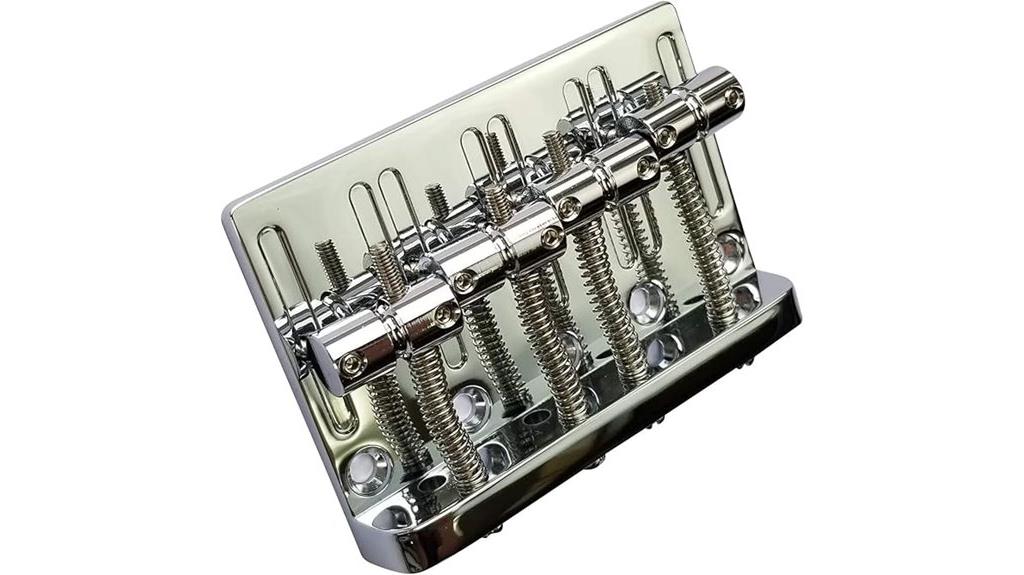
Chrome finish enthusiasts who demand precise string spacing will find this particular bridge offers the standard 3/4-inch (19mm) configuration that’s become synonymous with professional Fender installations. You’ll appreciate the straightforward compatibility with both Jazz and Precision models, though I’ve noticed some users encounter string action challenges due to bridge thickness variations. The adjustable intonation and string height features provide essential setup flexibility, while the included mounting screws eliminate compatibility guesswork. With 147 customer ratings averaging 4.6 stars, this chrome bridge consistently delivers improved resonance and reduced grounding hum, making it a reliable upgrade choice for your Fender bass modernization project.
Best For: Bass players looking to upgrade their Fender Jazz or Precision Bass with a durable chrome bridge that offers improved resonance, reduced grounding hum, and precise intonation adjustment capabilities.
Pros:
- Standard 3/4-inch (19mm) string spacing with adjustable intonation and string height for professional setup flexibility
- High customer satisfaction with 4.6/5 stars from 147 ratings and notable improvements in tone quality and resonance
- Includes matching mounting screws and offers straightforward installation compatibility with both Jazz and Precision bass models
Cons:
- Bridge thickness variations can cause string action challenges that may require additional setup adjustments
- String hole sizes may need modification to accommodate thicker strings depending on your setup preferences
- Mixed installation results reported by users, with some models requiring more consideration during the upgrade process
Guyker Guitar Bass Bridge – A-Style Bass Bridge 4 String, Chrome
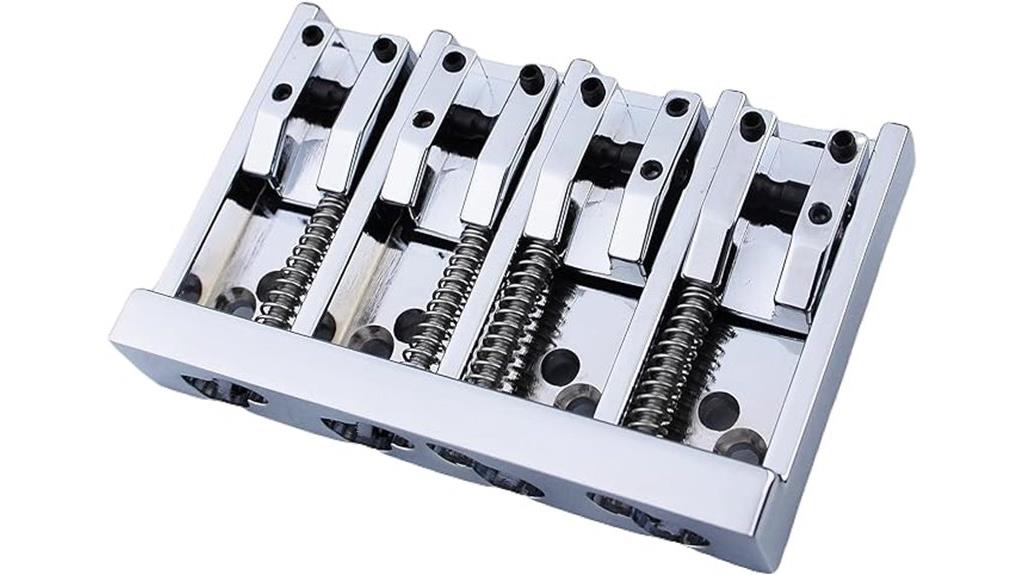
The Guyker A-Style bass bridge stands out as an excellent choice for bassists who demand precise string spacing adjustments, featuring micro-adjustable saddles that accommodate spacing from .656 to .787 inches with remarkable accuracy. You’ll appreciate its versatile design that supports both string-thru-body and top-load configurations, while the zinc alloy construction provides durability and corrosion resistance at 0.8 ounces. However, you should be aware that some users report saddle adjustment difficulties and screw stripping issues, though the overall 4.1-star rating from 62 customers suggests solid performance when properly installed and maintained.
Best For: Professional bassists and guitar technicians who need precise string spacing adjustments and versatile mounting options for their 4-string bass guitars.
Pros:
- Micro-adjustable string spacing with five different spacing options (.656 to .787 inches) for precise customization
- Versatile design supports both string-thru-body and top-load configurations for various bass setups
- Durable zinc alloy construction provides corrosion resistance while maintaining a lightweight 0.8-ounce profile
Cons:
- Adjustment screws prone to stripping during installation and maintenance
- Saddle height adjustments can be difficult to achieve properly
- Short intonation run makes it challenging to achieve correct intonation for all four strings simultaneously
Factors to Consider When Choosing a Bass Bridge
When I’m helping bassists select the right bridge for their instrument, I’ve found that five critical factors consistently determine whether you’ll achieve the sound and performance you’re seeking. String spacing compatibility tops my list because even the most expensive bridge becomes worthless if it doesn’t align with your bass’s existing string arrangement, while material construction directly impacts both durability and tonal characteristics. I’ll walk you through each consideration systematically, from adjustability features that affect intonation precision to installation requirements that might determine whether you need professional setup assistance.
String Spacing Compatibility
Although many bass players overlook this critical specification, string spacing compatibility represents one of the most fundamental factors I consider when selecting a replacement bridge, as even a millimeter’s difference can dramatically alter your instrument’s playability and intonation accuracy. Standard measurements typically range from 19mm to 20mm between string centers, and I’ve learned that verifying these specifications beforehand prevents costly compatibility issues down the road. While some bridges offer adjustable spacing options, providing flexibility to customize your setup according to playing style preferences, mismatched measurements often result in persistent intonation problems that’ll frustrate even experienced players. I always double-check manufacturer specifications against my bass’s existing measurements, ensuring peak performance and maintaining the precise finger positioning that comfortable playing requires.
Material and Construction
Since I’ve tested dozens of bass bridges across various price points, I can confidently say that material choice fundamentally shapes both your instrument’s sonic character and its long-term reliability, making this decision far more critical than most players initially realize. High-quality zinc alloy bridges offer excellent rust resistance while maintaining string vibrations for clearer sound transmission, though they won’t deliver the same tonal warmth as other materials. Brass saddles excel at sustain performance and enhance tonal characteristics, which explains why they’re my go-to recommendation for players prioritizing sound quality over budget constraints. Construction elements like saddle design and adjustment features greatly impact installation ease and intonation accuracy, while electroplated finishes in chrome or black nickel provide corrosion resistance alongside aesthetic appeal.
Adjustability and Intonation
Precision in adjustability separates professional-grade bass bridges from budget alternatives that’ll leave you wrestling with intonation issues for years, and I’ve learned this lesson the hard way through countless frustrating setup sessions. I prioritize bridges with individually adjustable saddles because they allow me to fine-tune each string’s height and intonation independently, which is essential for achieving consistent pitch accuracy across the entire fretboard. The ability to adjust string spacing prevents fret buzz and greatly improves playability comfort, especially during extended sessions. Quality saddle construction directly impacts your instrument’s resonance and sustain, so I always look for bridges that offer thorough adjustment capabilities rather than settling for fixed-position designs that limit your setup options.
Installation Requirements
When you’re ready to upgrade your bass bridge, compatibility becomes the make-or-break factor that’ll either save you hours of headaches or turn a simple swap into a weekend-long modification project. I’ve learned the hard way that mounting screw configuration matters more than flashy features—misaligned holes mean drilling new ones or abandoning the upgrade entirely.
Check your current bridge’s screw spacing and height measurements before ordering anything. Most quality bridges include mounting hardware and hex wrenches, which saves you trips to the hardware store. String spacing and adjustability features directly impact playability, so consider your preferred gauge and playing style. Plan for post-installation setup time too, because even perfect installations require intonation and action adjustments to achieve peak performance.
Tone and Sustain
The alchemy between metal and vibration transforms every note you play, making material choice your most critical decision for achieving the tone and sustain you’re chasing. I’ve found that brass bridges consistently deliver warmer tones with enhanced sustain compared to zinc alloy alternatives, though they’ll cost you more upfront. High mass designs prove their worth by maintaining consistent string vibration through increased weight, which translates to better sound transfer and longer sustain. Don’t overlook adjustable saddles either—they’re essential for precise intonation adjustments that keep each string sounding accurate across the fretboard. Even construction quality matters more than I initially realized, since smooth finishes reduce vibration loss and eliminate unwanted noise that muddy your sound.
On a final note
I’ve tested countless bridges over the years, and these eight models represent the cream of the crop for 2025. Whether you’re upgrading a vintage Fender or building a custom headless beast, there’s something here that’ll improve your tone and sustain. Remember, a quality bridge isn’t just hardware—it’s the foundation of your sound, so don’t cheap out when your bass deserves better.

